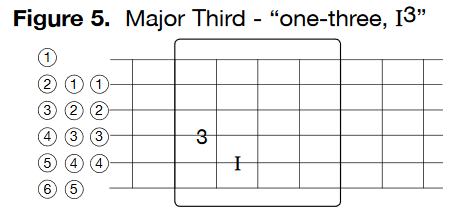Bass Harmony Numerics = Part One, 1, I.
Music presents an invisible sound for the ear to hear. The eye then sees a silent visible mark
which "re-presents" the invisible sound.
In music, marks are either signs> or symbols.
Signs tell us "to do" or "not to do" something.
Symbols are used to represent the sound.
The 1st sign of music is the natural ♮.
The 1st symbol of music is the "alpha" letter, as in alpha-beta or alphabet. There are seven natural letters in music: A B C D E F G.
The 2nd sign of music is flat ♭, and the 3rd sign of music is sharp ♯. The flat and sharp signs are called chromatic,
and they tell us "not" to play a natural letter.
Numeric, as in "alpha-numeric", is the 2nd symbol of music, and simply means "to measure".
Numeric has three parts: the word, the number, and the numeral, as in one, 1, I.
Notice that word one, number 1, andnumeral I, all sound the same when spoken, but look different as silent symbols.
Let’s begin by making the sound of the letterE, "open" string 4 (on a 4 or 5 string bass) or "open" string 5 (on a 6 string bass).
Open means "strike the string, but do not place a finger on the string". This "open E" is the sound of the fundamental.
The fundamental, also called the root or the tonic, and is the lowest and loudest frequency of a single string vibrating as a whole.
The fundamental is the pitch by which we identify the letter name of word one, number 1 and numeral I.
Also, the letter name of the fundamental "one, 1, I", is the "key".
Remember, the fundamental is the 1st sound in the 1st octave - and it is not a harmonic.
Harmonics, also called overtones or partials are frequencies higher and more quiet than the fundamental. Harmonics are produced by the
vibrations of a string divided into any number of equal parts. In other words, a string not only vibrates as a whole, but it also vibrates in fractions.
When the fundamental is sounded, there are many other harmonic frequencies that naturally vibrate with it.
Harmonics progress in a specific number order of sound called the harmonic series. Here is the harmonic series number order: 8, 12, 15, 17.
To produce loud and clear harmonics on your bass, touch the string very lightly "directly above the fret". This is the exact point that divides
the string into equal parts. The string will then vibrate in smaller equal parts and this will produce the sound of the harmonic.
It helps to strike the string near the "bridge" and to not push the string down toward the fret. Also, be sure to quickly lift your finger off the
string after sounding the harmonic so that you do not dampen the vibrating string.
Now, to hear the 1st harmonic, lightly touch directly above fret 12. This is tone number 8 and it sounds one octave higher than the fundamental one, 1, I.
The 2nd harmonic, directly above fret 7, is tone number 12 and sounds one octave higher than tone 5. The 3rd harmonic, tone number 15
(two octaves higher than the fundamental), is above fret 5. And the 4th harmonic, tone number 17 (two octaves higher than tone 3), is above fret 4.

There are many more harmonics than these four, in fact, there is an infinity! But that would take eternity...so, let’s convert the harmonic numbers (8, 12, 15, 17)
into 1st octave harmony numbers, 1 8 5 3 - or simply 1 3 5!
Next, let’s turn the harmony letter into harmony numeral I, and then add a harmony number to harmony numeral I.
Here’s an example, when number 1 is added to harmony numeral I, "one-one, I1" is the result. And even though there are two symbols (numeral I and number 1)
there is only one sound! This is because the sound of "one, 1, I " - whether it’s a word, number, or numeral - is the sound of the
same letter. In other words, in the "key" of C, word one is C, number 1 is C and numeral I is C. All the different symbols (one, 1, I),
have the same letter and therefore the same sound.
"Two symbols with one sound" is the interval unison or prime.
Figure 2.

While it’s true that "one-one, I1" only has one sound, when we combine other harmony numbers (8, 5, 3) with harmony numeral I, we
create intervals that have "two symbols and two sounds"!
Here are some "two symbol, two sound" intervals created by adding a harmony number (other than 1) to harmony numeral I: Octave, "one-eight,
I8".
Figure 3

Perfect 5th, "one-five, I5". Figure 4.

Major 3rd, "one-three, I3". Figure 5.

Remember, we learn harmony "in order" (theharmonic series order), so that we may play harmony "out of order”. In other words, we are
"free to choose" and combine intervals in any order we wish. In a word - improvise!
So, till next time, have some harmonic harmony fun. I’ll be listening...
Figures 6 & 7.

Return to Proficient Lessons